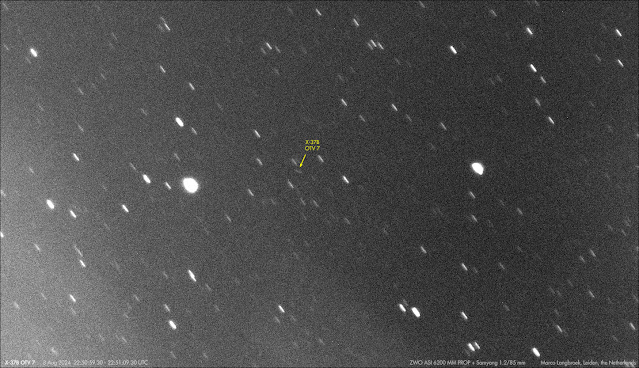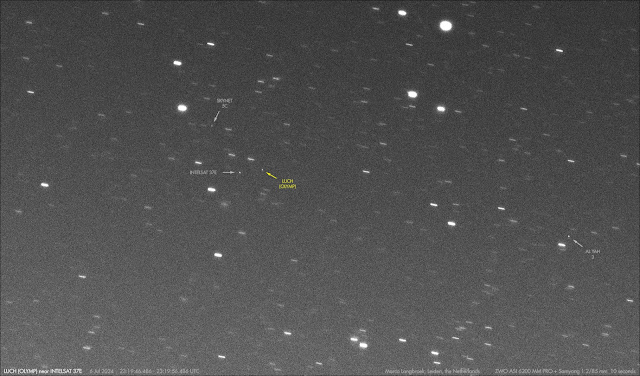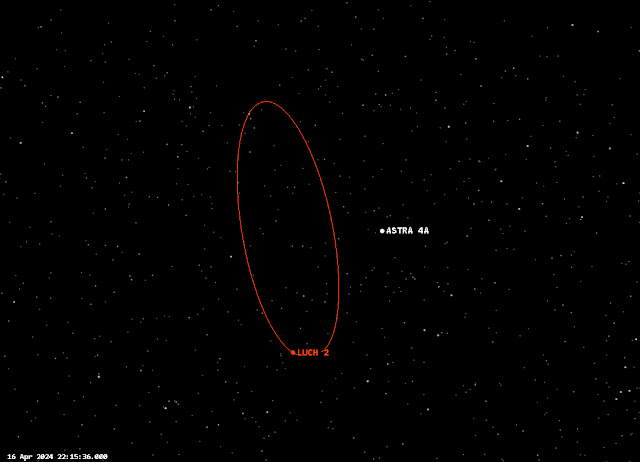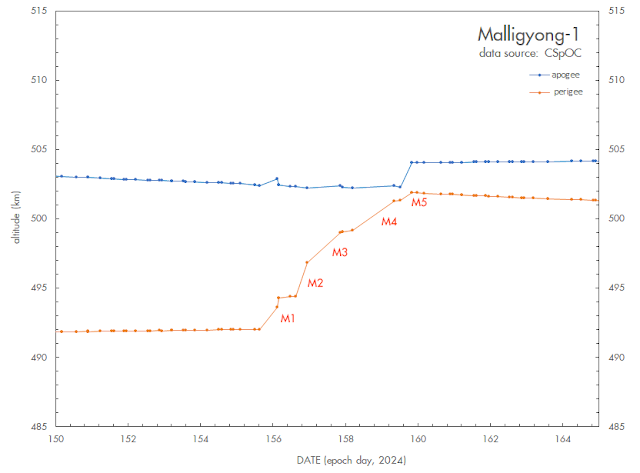 |
| X-37B OTV 7 near apogee imaged by the author on 3 October 2024. Click to enlarge |
It looks like the time on orbit is about to end for mission OTV 7 of the enigmatic US Space Force X-37B spaceplane (2023-210A). Launched on 29 December 2023, it went into an unusual Highly Elliptical Orbit with apogee near 38 600 km and perigee near 300 km and an orbital inclination of 59 degrees (see various earlier blogposts).
On October 10, the US Space Force announced that OTV 7 "will begin executing a series of novel maneuvers, called aerobraking, to change its orbit around Earth and safely dispose of its service module components in accordance with recognized standards for space debris mitigation"
I already wrote earlier, e.g. in this blogpost from February, that the mission likely would end by using aerobraking in perigee to lower apogee, circularize in a Low Earth Orbit, and then land.
Aerobraking is a technique where, by a manoeuver in apogee, the perigee altitude of the orbit is lowered such that it is in the top of the atmosphere: not low enough to make it reenter, but enough to significantly slow it down. When the spacecraft goes through perigee in that situation, it experiences enhanced drag, that will result in drastically lowering the apogee of the orbit, certainly after a few of such perigee passages.
This will bring the orbit down and eventually change the Highly Elliptical Orbit character into a Low Earth Orbit. Orbital velocity near perigee (over 10 km/s while in a Highly Elliptical orbit with apogee near 39 000 km) will be drastically reduced (to 6.8 km/s) by this, allowing the vehicle to reenter the atmosphere and land without experiencing too excessive forces during reentry.
It looks like the process of lowering perigee might already have started around October 4, when for the first time perigee (while earlier just above 300 km) seems to drop below 300 km:
 |
| OTV 7 apogee and perigee altitudes over time. NOTE: logarithmic Y-axis! Click to enlarge |
This is difficult to say for certain, as frequent larger and smaller manoeuvers by OTV 7 (it seems to have manoeuvered daily, as it never was on the ephemerids during a next observation) combined with a sketchy observational coverage (most of the observations from the last two months have been done by me, with some by Tomi Simola), means that orbit determinations are not always that easy and it is not clear how real the minor variations in perigee altitude from orbit determination to orbit determination are.
The wording of the US Space Force news item is such, that it seems to suggest that after apogee lowering and orbit circularization through aerobraking, OTV 7 might for a while continue its mission in a lower (Low Earth) orbit, as they write:
"Once the aerobrake maneuver is complete, the X-37B will resume its test
and experimentation objectives until they are accomplished, at which
time the vehicle will de-orbit and execute a safe return as it has
during its six previous missions".
So rather than land directly after the aerobraking sequence is finished, it might stay on orbit for days, weeks or months, in an orbit that is more like those of previous X-37B missions.
Over the past two months, perigee has been kept on the equator (argument of perigee kept near 180 degrees). That is a situation where during a perigee pass, there is the possibility to change the orbital inclination. So it is possible that near the end of the aerobraking sequence, the orbital inclination (currently 59 degrees) will be changed to a lower value, e.g. around 40 degrees as with previous X-37B missions in LEO.
As an interesting aside, the US Space Force bulltein also mentions that mission OTV 7 in its unusual HEO orbit "has conducted radiation effect experiments and has been testing Space Domain Awareness technologies in a Highly Elliptical Orbit".
 |
| X-37B spaceplane. Image: US Space Force |
















































